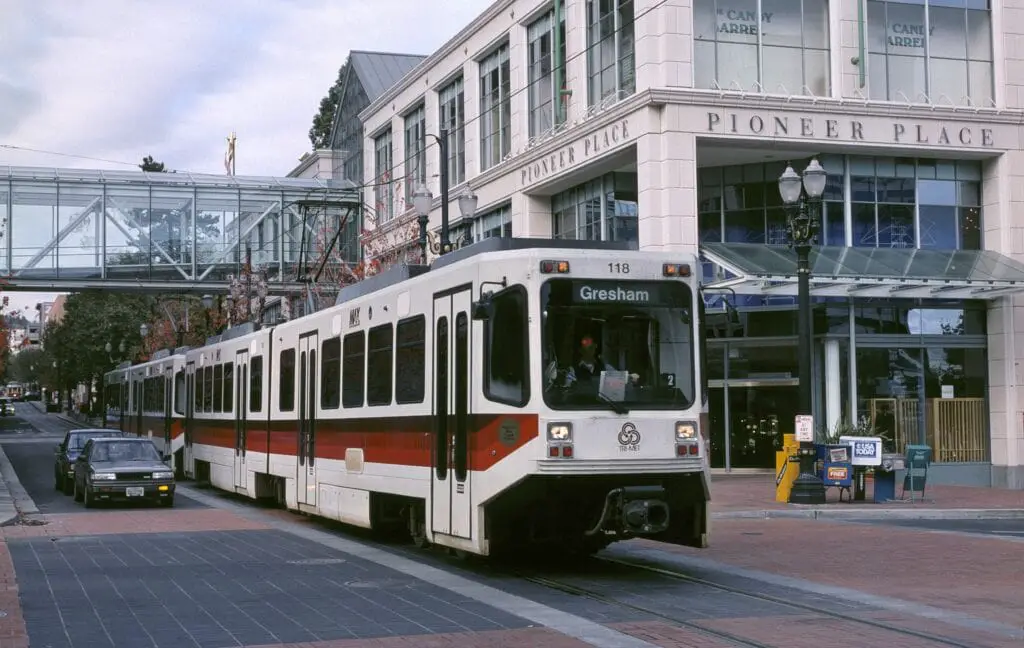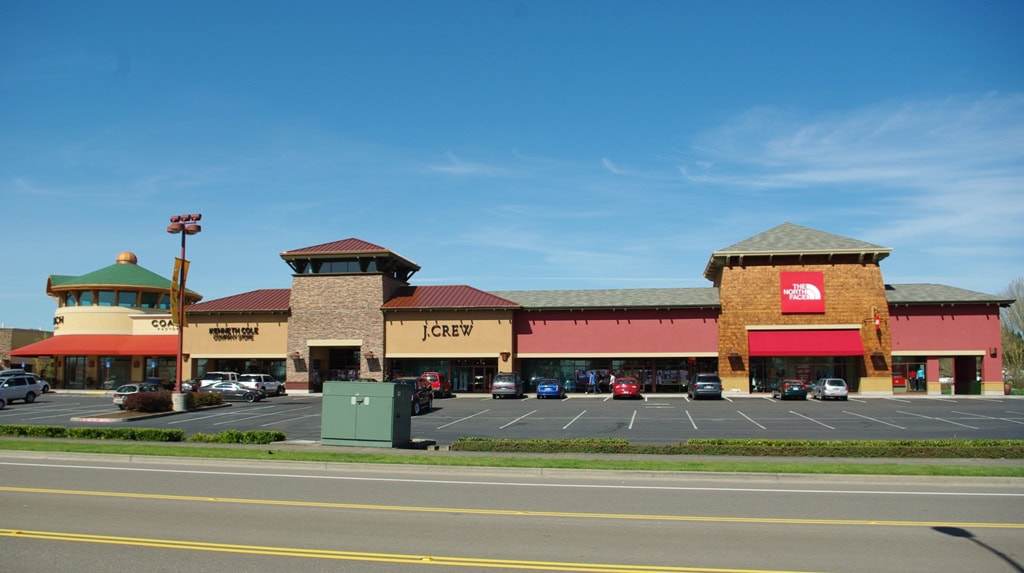The Allure of Urban Shopping: Exploring Pioneer Place Mall
The Heart of Downtown Portland’s Retail Scene
Nestled in the vibrant downtown of Portland, Oregon, Pioneer Place Mall is a testament to modern urban retail.
This upscale shopping mall, sprawling across four whole city blocks, is not your average shopping destination.
Its layout, a carefully crafted maze of retail spaces, dining venues, and an office tower, is designed to encapsulate the essence of urban sophistication.
The mall stretches between SW Morrison and Taylor Streets and SW Third and Fifth Avenues, marking its territory in the city’s heart.
Architectural Marvel and High-Performance Sales
Pioneer Place’s architecture is a visual treat, featuring interconnected buildings linked by skywalks and underground sections.
This intricate design is a functional aspect of the mall and an architectural highlight, setting it apart from typical shopping centers.
In 2014, this unique design and strategic location significantly contributed to Pioneer Place’s becoming the third-highest-selling mall in the United States based on sales per square foot, surpassed only by renowned shopping destinations like Bal Harbour Shops and The Grove at Farmers Market.
A Hub for Things to Do in Portland, Oregon
While quieter these days, Pioneer Place remains noteworthy in Portland, Oregon.
With around 30 tenants, it still offers a variety of experiences, albeit on a smaller scale.
Once bustling with visitors, this mall presents a more intimate setting for those exploring downtown Portland.
Though its heyday of high foot traffic and an extensive tenant list has passed, Pioneer Place retains its charm as a destination where visitors can enjoy select shopping and dining options, reflecting Portland’s unique urban lifestyle.
From Vision to Reality: The Early Days of Pioneer Place
A New Beginning in the Heart of Portland
Pioneer Place‘s journey began with the construction of its first phase, Pioneer Place I, in 1988 and culminated in its grand opening in 1990.
This marked a new era in Portland’s retail landscape. The site’s transformation required the demolition of the Corbett Building, a piece of Portland’s architectural history dating back to 1907.
This bold move paved the way for a modern shopping experience in downtown Portland, signaling a significant shift in the city’s commercial development strategy.
Expanding Horizons with Pioneer Place II
The evolution of Pioneer Place continued with the development of its second phase, Pioneer Place II.
This expansion, which began in 1998, added a substantial 150,000 square feet of retail space at a considerable investment of around $60 million.
The addition of Pioneer Place II, also known as The “Rotunda Shops,” represented a commitment to enhancing the shopping experience and diversifying the range of offerings available to visitors.
This development phase underscored the mall’s ambition to become a key player in the urban retail sector.

A Changing Retail Landscape
Over the years, Pioneer Place witnessed significant changes in its tenant mix.
A notable shift occurred in 2010 when Saks Fifth Avenue, a long-standing luxury retailer at the mall, closed.
This departure made room for new tenants like H&M and an Apple Store, reflecting the evolving consumer preferences and the dynamic nature of retail trends.
These changes marked a turning point for Pioneer Place, showcasing its ability to adapt and thrive amidst a rapidly changing retail environment.
Embracing Innovation and Diversity at Pioneer Place
A New Era of Workspaces in Retail
Pioneer Place welcomed WeWork in February 2017, a significant move that reflects the changing landscape of retail and work environments.
This marked one of the first shared workspaces integrated into a shopping mall, with WeWork occupying 30,000 square feet.
This innovative step was more than expanding tenant variety; it represented a shift towards multifunctional retail space use, blending traditional shopping with modern work culture.
The Unique Mix of Tenants
Pioneer Place’s tenant lineup is diverse, encompassing various stores and attractions catering to different tastes and needs.
The mall’s 356,000-square-foot area includes 30 stores, including luxury brands like Tiffany & Co., Saint Laurent, Gucci, and Louis Vuitton, popular entertainment options such as a Regal Cinemas theater, and fashion retailers.
This blend of tenants illustrates the mall’s commitment to providing a comprehensive shopping and entertainment experience catering to a wide demographic.
Culinary Delights Underground
One of the unique features of Pioneer Place is its underground food court, Cascades.
Located beneath Pioneer Tower, this dining area offers a variety of culinary options in a distinctive setting.
Connected to a parking garage, Cascades serves not only as a convenient dining spot for shoppers but also as an attraction in its own right, adding to Pioneer Place’s overall appeal as a destination for both shopping and dining.

Pioneer Place and Portland’s Public Transit Synergy
Seamlessly Connected to the City
Pioneer Place’s integration with Portland’s public transportation system is a key feature that enhances its accessibility and appeal.
The mall is strategically positioned along the Portland Transit Mall, served by numerous TriMet bus routes and the MAX Light Rail.
This seamless connection with the city’s transport network makes Pioneer Place an easy-to-reach destination for locals and visitors, reinforcing its status as a central hub in downtown Portland.
The MAX Light Rail: A Gateway to Pioneer Place
All five MAX Light Rail system lines serve Pioneer Place, with stations conveniently located within a block of the mall.
The proximity of these stations – Pioneer Place/5th Avenue, Pioneer Courthouse/6th Avenue, and others – facilitates effortless access to the mall’s offerings.
Since its opening in 1990, these adjacent stations have significantly boosted the mall’s accessibility, contributing to its high foot traffic and popularity.
Adapting to Urban Changes
In 2020, the closure of two directly adjacent MAX stations on Morrison and Yamhill Streets marked a change in Pioneer Place’s immediate transit landscape.
This decision, which aims to reduce travel time for MAX riders, reflects the dynamic nature of urban development and transportation planning.
Despite these changes, Pioneer Place remains a central, easily accessible location in downtown Portland, well-connected to the broader city through an efficient public transport network.
Navigating Through Challenges: Pioneer Place’s Resilience
Facing a Decline in Foot Traffic
Like many urban shopping centers, Pioneer Place has recently faced its share of challenges.
The mall saw a significant decrease in visitors, with foot traffic almost 80% lower in January 2023 than in January 2019.
This decline was a stark indication of the difficulties retail spaces face in adapting to changing consumer behaviors and external factors.

The Struggle Against a Changing Downtown
The challenges at Pioneer Place were not just about declining visitors.
The mall in downtown Portland was surrounded by a landscape of boarded-up windows, a visual reminder of the city center’s broader struggles.
This situation posed additional hurdles in attracting visitors and maintaining the mall’s status as a desirable destination.
Signs of Recovery and Hope
Despite these difficulties, there were signs of recovery and resilience at Pioneer Place.
By May 2023, the decrease in visitors had improved to 50% compared to 2019 levels.
This gradual increase in foot traffic was a positive indicator of the mall’s potential to bounce back, suggesting a nascent recovery in the heart of downtown Portland.
Pioneer Place’s ability to endure and adapt to adversity reflects its enduring appeal and the continued relevance of urban retail spaces.

Revitalizing Pioneer Place with New Ventures
Fuller’s Burger Shack: A Nostalgic Addition
Pioneer Place welcomed Fuller’s Burger Shack, a culinary venture that pays homage to Portland’s dining heritage, signaling rejuvenation.
Opening its doors in 2023, this diner-style eatery took over a space formerly occupied by Burger Fi.
Fuller’s Burger Shack, a spinoff of the iconic Fuller’s Coffee Shop, introduces nostalgia and local flavor to the mall, offering a classic American dining experience with a twist.
A Menu Rooted in Tradition and Affordability
Fuller’s Burger Shack stands out for its commitment to tradition and affordability.
The menu is centered around the titular burger, made with 21-day-aged beef and a secret sauce, which has been the recipe since Fuller’s Coffee Shop began in 1947.
The pricing strategy is notably customer-friendly, especially for downtown Portland. The classic burger is priced at just $6.95.
The menu also caters to diverse dietary preferences, featuring options like the Beyond Burger and traditional diner drinks, from milkshakes to craft beers.
Enhancing the Mall’s Appeal and Prospects
The introduction of Fuller’s Burger Shack is more than just a new dining option; it represents a strategic move to enhance Pioneer Place’s overall appeal.
By offering a blend of retro charm and modern dining trends, the eatery is poised to attract a broad range of patrons, contributing to the mall’s potential for future growth and development.
This addition reflects Pioneer Place’s adaptive strategy, aiming to remain a dynamic and attractive destination in Portland’s urban landscape.

Reflecting on Pioneer Place’s Journey
A Story of Evolution and Adaptation
Pioneer Place’s story is one of continual evolution and adaptation.
From its inception in the late 1980s to its current state, the mall has navigated through various phases of development and challenges.
It has transformed from a conventional shopping center to an urban landmark, intertwining retail, dining, and modern workspaces.
The mall’s journey reflects the broader trends and shifts in urban retail and consumer behavior.
Enduring Through Challenges
Despite facing significant challenges, including a substantial decline in foot traffic and the changing dynamics of downtown Portland, Pioneer Place has shown remarkable resilience.
Some recovery observed in recent months is a testament to the enduring appeal of this urban shopping destination and its capacity to adapt to changing circumstances.
Looking Towards a Promising Future
As Pioneer Place continues to evolve, incorporating new and diverse tenants like Fuller’s Burger Shack, its future appears promising.
The mall’s ability to blend nostalgia with modernity, luxury with accessibility, and shopping with experiences positions it well in the ever-changing landscape of urban retail.
As it moves forward, Pioneer Place will symbolize Portland’s dynamic spirit, ready to embrace new opportunities and continue its legacy as a central hub.








